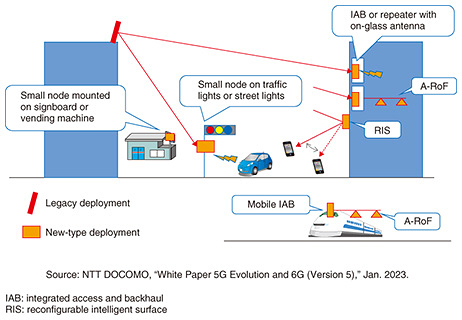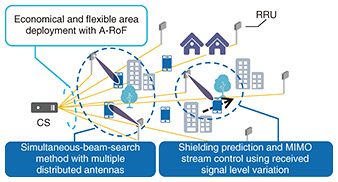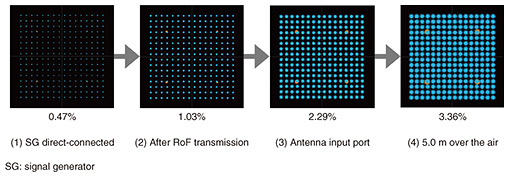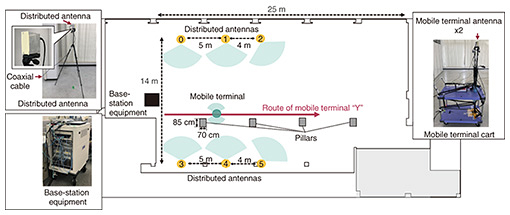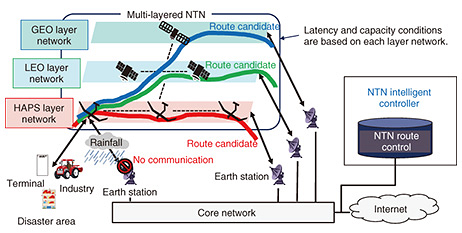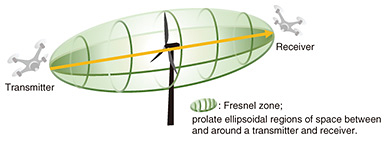 |
|||||||||||||||||||||||
|
|
|||||||||||||||||||||||
|
Feature Articles: Keynote Speeches and Workshop Lectures at Tsukuba Forum 2023 Vol. 21, No. 9, pp. 52–57, Sept. 2023. https://doi.org/10.53829/ntr202309fa8 Wireless Technologies for Accelerating High-capacity Transmission, Low Energy, and Application-area ExpansionAbstractThis article describes recent research and development of wireless technologies for the sixth-generation mobile communications system (6G) and the Innovative Optical and Wireless Network (IOWN) at NTT Access Network Service Systems Laboratories. We at NTT Access Network Service Systems Laboratories believe that IOWN and 6G have the same targets for future networks. Therefore, to actualize 6G/IOWN, we are investigating wireless technologies focusing on high-capacity transmission by combining them with optical technologies, coverage extension for the sky including satellite-communication systems, application-area expansion, and low energy as the common wireless technological issues. This article introduces these wireless technologies and their future prospects. Keywords: 6G, IOWN, high capacity 1. IntroductionNTT proposed the Innovative Optical and Wireless Network (IOWN) [1] in May 2019 to construct future optical and wireless networks for the 2030s. IOWN will provide innovative optical technologies, high transmission capacity, and huge computer resources compared with conventional networks. However, the sixth-generation mobile communications system (6G) has been announced worldwide and focuses on extreme high data rate/capacity, coverage extension, and low energy [2], which have been published in white papers of many research institutes [3]. In Japan, NTT DOCOMO first published a white paper related to 6G wireless technologies in January 2020 and has updated its content for the 5th edition in Nov. 2022 [2]. We at NTT Access Network Service Systems Laboratories believe that IOWN and 6G have the same targets for future networks. Therefore, we are investigating wireless technologies combined with optical technologies for actualizing 6G/IOWN. However, we need to obtain worldwide agreement for the future of 6G. Therefore, NTT and NTT DOCOMO are expanding 6G collaboration with world-leading vendors [4] in Japan and overseas. Regarding the wireless technologies for 6G, it is effective to use the millimeter-wave and sub-terahertz bands to increase transmission capacity. However, we need to use a large amount of wireless equipment to transmit wireless signals. This is because radio-propagation loss increases in higher frequency bands such as millimeter-wave and sub-terahertz bands. Therefore, we also need a more flexible wireless-area design compared with conventional cellular network design. We have been investigating a new radio (NR) network topology in the space domain, as shown in Fig. 1. To achieve this topology, we use many remote radio units (RRUs), which consist of wireless equipment and antennas, to transmit wireless signals. Therefore, distributed multiple-input multiple-output (MIMO) is effective in transmitting wireless signals from different RRUs. We connect a central station (CS) to RRUs by using optical fiber because of low optical transmission loss. To use the advantages described above, we proposed a distributed MIMO system connected by analog radio over fiber (A-RoF) in higher frequency bands.
Because we construct a flexible network topology by using this NR network topology, this topology is also suitable for coverage extension involving satellites and high altitude platform stations (HAPSs) and application-area expansion. This article introduces wireless technologies focusing on high-capacity transmission, coverage extension, application-area expansion, and low energy, which are common issues with 6G/IOWN and their future prospects [5]. 2. High-capacity transmissionWe now describe the distributed MIMO systems in higher frequency bands, as shown in Fig. 2. We use A-RoF, which connects a CS to RRUs.
2.1 A-RoFAs shown in Fig. 2, a star topology is the basic topology for A-RoF transmission. However, a cascade topology is considered from the viewpoint of network flexibility. A cascade topology uses optical power splitters and an optical multiplexer/demultiplexer. Therefore, optical transmission loss passing through these optical devices increases. Consequently, there is the problem of a limited number of connecting RRUs using a conventional cascade topology. To solve this problem, we proposed a cascade-topology approach that involves using an optical thin-film filter. This filter enables the selected wavelength with low optical transmission loss to pass through and reflect other wavelengths, which makes it possible to increase the number of connected RRUs. By aggregating RRUs’ signal processing, which requires high energy, at a CS, A-RoF enables simple and low-power-consumption RRUs. We also investigated a remote beamforming scheme [6] and conducted an experiment of 5G-NR signal transmission, which is based on the physical specification of 5G NR developed by the 3rd Generation Partnership Project (3GPP), using the remote beamforming scheme with beam table. This experiment successfully demonstrated simultaneous 4K-video transmission in both uplink and downlink directions. We also measured the error vector magnitude (EVM) of 5G-NR signals by using 20-km single mode fiber from a CS to RRUs. The measured EVM and signal constellation on each measured point of the experimental system are shown in Fig. 3. On the basis of the measured EVM of 5 m over the air, we confirmed about 3.36% EVM performance, which satisfies the 3.5% requirement by the 3GPP physical layer specification for 256 quadrature amplitude modulation [5].
2.2 Distributed MIMO technologyThere are several issues, described in a previous study [2], that need to be addressed for developing a distributed MIMO system in higher frequency bands. To construct MIMO propagation paths, we use multiple distributed antennas as the transmitting points. This subsection introduces technologies for controlling distributed propagation paths. To operate many RRUs effectively, high-density deployment of RRUs is required. Therefore, we also need to carry out a large amount of beam-search processing. To solve this problem, we proposed a simultaneous-beam-search method with multiple distributed antennas in RRUs that use the same frequency bands and search timing. We found that this method experimentally achieves better performance compared with the conventional method. The search time with our method is not proportional to the number of RRUs and terminals [5]. It should be noted that this method does not increase beam-search overhead resources in the time domain. NTT, NTT DOCOMO, and NEC demonstrated a distributed MIMO system, which enables continuous wireless connections in the 28-GHz band by eliminating shielding issues [7]. This system adaptively selects connected RRUs’ antennas on the basis of the environmental information of radio propagation and terminal location with the distributed-control approach. An overview of the experimental area and system is shown in Fig. 4. We compared A-RoF transmission with coaxial cable transmissions in terms of throughput performance. This system consists of distributed MIMO with A-RoF transmission, which connects a CS to two RRUs. We experimentally confirmed wireless transmission with bi-directionally time-division duplex operation in distributed MIMO using A-RoF transmission for the 28-GHz band. A-RoF transmission achieved almost the same throughput performance as coaxial cable transmissions.
3. Coverage extensionNTT is pursuing the Space Integrated Computing Network, which achieves 100% coverage area including terrestrial and non-terrestrial, by using the multi-layered non-terrestrial network (NTN) system [8]. As shown in Fig. 5, the multi-layered NTN system consists of geostationary orbit (GEO) satellites, low-Earth orbit (LEO) satellites, and HAPSs. Therefore, we can select the optimum wireless transmission route by taking into account the effect of radio propagation loss and channel capacity. For example, because the wireless-transmission route has increased path loss due to rain attenuation, we can control the wireless-transmission route by selecting the clear-weather route without rain attenuation. Therefore, we proposed a route-control technique to increase the channel capacity of the multi-layered NTN system [5, 8].
Satellite communication requires a high-capacity feeder-link from the satellite to earth station. This is because the satellite must transmit a huge amount of data from many terminals on Earth through the service-link. From this point of view, we studied satellite MIMO transmission of the feeder-link and developed prototype satellite MIMO equipment, which will be used in the experimental evaluation in LEO [8]. NTT has been cooperating with the Japan Aerospace Exploration Agency (JAXA) to demonstrate the practicality of satellite MIMO technology in LEO. NTT and JAXA will continue the experimental evaluation of this technology with the Innovative Satellite Technology Demonstration-4*, followed by an experimental evaluation with the Innovative Satellite Technology Demonstration-3 [5].
4. Application-area expansionTo increase the potential advantages of high-capacity transmission and coverage extension, we investigated the following two wireless technologies by focusing on application-area expansion. The first is the base-station-selection-control technology that is based on localization information using wireless communication radio. A localization technology has attracted attention for 6G. The conventional base-station-selection technology uses the received-signal-power-based approach without sleep control in the base station. Our technology uses the terminal-localization information using wireless communication radio to recognize the communication area. Therefore, it enables the terminal to precisely select the base station without use of localization systems, such as the Global Positioning System. We evaluated the performance of our base-station-selection-control technology using the license-free 60-GHz band. This evaluation experiment involved using a wireless local area network system, called WiGig, located on a formula car traveling over 300 km/h as a terminal. We also conducted an experiment from the view point of low energy in base stations [9]. When the formula car approached two base stations, one base station was powered on and the other remained off. The other base station is then powered with the formula car approaching by using our localization technology. It should be noted that the formula car traveled over 260 km/h. We found that our technology decreased the active time of base stations by 60% compared with the conventional technology. The second technology is for non-contact damage inspection of large structures [10]. We began a practical experiment on applying this technology to inspect a wind power windmill to contribute to a future carbon-neutral society. We expect good results by applying this technology to the inspection of ocean-based wind-power equipment. This technology can also be combined with the coverage-extension technologies described above. As shown in Fig. 6, our non-contact inspection technology transmits a weak radio signal between two drones sandwiching the target structure (weak radio equipment can be operated without a license). Our technology detects and analyzes the variation in the received signal level at the receiver drone. Therefore, we can detect the damage on a large structure in a non-contact manner. The conventional technology requires a non-operation period because it requires on-site visual structural inspection as well as inspection from images. We plan to use our non-contact damage-inspection technology in combination with the conventional technology to shorten the non-operation period.
5. ConclusionThis article described our research and development of wireless technologies for actualizing 6G/IOWN and their future prospects. We expect to increase the performance of wireless technologies by focusing on high-capacity transmission, coverage extension, and low energy. We also expect to expand the application area of wireless technologies by achieving these targets. References
|
|||||||||||||||||||||||









